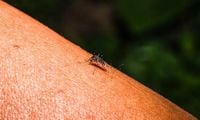Southern China is grappling with a significant outbreak of chikungunya, a mosquito-borne viral infection, with over 4,000 confirmed cases reported in the past two weeks. The city of Foshan, located in Guangdong province, has been the epicenter of this surge, with the Shunde district alone accounting for approximately 90% of infections. As of July 26, 2025, health authorities have documented 4,014 cases, marking an unprecedented spike compared to previous years.
The outbreak has drawn intense public health attention, prompting local and provincial officials to implement control measures aimed at curbing the virus's spread. The World Health Organization (WHO) has underscored the seriousness of the situation, noting that chikungunya is transmitted via bites from infected Aedes mosquitoes and typically causes fever and severe joint pain, symptoms that can be debilitating though fatalities remain rare.
Sun Yang, deputy director of China's National Centre for Disease Control and Prevention, described the situation during a news conference in Foshan as "quite severe," emphasizing the urgency of the response. Photographs broadcast by CCTV revealed patients hospitalized in beds protected by mosquito nets, highlighting the efforts to prevent further transmission within medical facilities. Local media reports indicate that authorities have nearly doubled the number of mosquito-proof isolation beds to 7,220 to accommodate the growing patient load.
The Guangdong provincial health authorities have mobilized a province-wide campaign to eliminate stagnant water sources, critical breeding grounds for mosquitoes. An open letter issued on July 24 urged residents to participate actively in removing standing water from household items such as flowerpots, coffee machines, and spare bottles. The Health Commission in Foshan has even established fines up to 10,000 yuan ($1,400) for violations of these mosquito control policies, signaling the seriousness with which officials are treating the outbreak.
Complicating containment efforts, the outbreak coincides with the summer typhoon season and heavy rainfall, which create ideal conditions for mosquito proliferation. The Standing Committee of the Communist Party of China’s Guangdong Provincial Committee convened on July 25 to assess the situation, acknowledging the critical stage of epidemic control and the challenges ahead. Officials cautioned against complacency, emphasizing that ongoing vigilance is essential to prevent further escalation.
While the majority of cases remain concentrated in Foshan, chikungunya infections have also been reported in other Guangdong cities, including Guangzhou, Yangjiang, and Zhanjiang. The neighboring city of Macao confirmed its first imported case this year on July 18, involving a patient who had recently visited Foshan's Shunde district. This development highlights the potential for wider regional spread, although northern parts of China face a relatively lower risk due to less favorable conditions for mosquito breeding.
Experts like Zhuang Shilihe, a public health specialist based in Guangzhou, stress that prevention hinges on controlling mosquito populations and personal protective measures. "At the community level, areas with high mosquito density or standing water should be promptly cleared," Zhuang advised. "Individuals are encouraged to use mosquito repellent, wear long sleeves and pants, and protect exposed skin such as the neck." Guangdong’s recent launch of a province-wide mosquito eradication campaign reflects these recommendations, though the impact of such measures may take time to manifest due to the virus's incubation period of two to nine days.
Chikungunya virus transmission typically peaks during the summer months, but experts warn that increasingly hot and humid weather could extend the transmission season into September. The current outbreak is believed to be driven by a combination of factors, including the virus's high global prevalence, favorable climatic conditions, and the presence of an imported Indian Ocean lineage strain particularly efficient at spreading through Aedes mosquitoes.
The virus was first detected in China as an imported case in 1987, with the first significant spike occurring in 2010 in Dongguan city, also in Guangdong province, when 253 cases were reported. Since then, smaller outbreaks have occurred but none have reached the scale of the current epidemic. Liu Qiyong, chief vector-borne disease expert at the Chinese CDC, explained that the high global prevalence of chikungunya, combined with the local presence of the mosquito vector and conducive weather conditions, has fueled this unprecedented outbreak.
Clinically, chikungunya manifests with sudden onset of fever and severe joint pain, symptoms so characteristic that the name "chikungunya" translates to "bent over" in reference to the posture adopted by sufferers due to joint discomfort. Other symptoms can include headache, muscle pain, joint swelling, rash, fatigue, and nausea. While most patients recover within about a week, some experience prolonged joint pain and, in rare cases, lingering heart, eye, or neurological complications.
There is currently no specific antiviral treatment for chikungunya; management focuses on symptom relief. Two vaccines have been approved in several countries and recommended for at-risk populations, but they are not widely available or used in China at this stage. Health authorities continue to emphasize preventive actions, including the use of insect repellents, wearing protective clothing, ensuring window and door screens are intact, and avoiding travel to outbreak areas when possible.
The Beijing Center for Disease Prevention and Control (CDC) has issued public advisories affirming that the risk of local transmission in the capital remains extremely low, although the city occasionally encounters imported cases due to increasing international travel. The Beijing CDC has provided detailed guidance on chikungunya transmission, clarifying that it is not spread through casual contact such as coughing or sneezing but solely through mosquito bites.
As southern China confronts this challenging outbreak, public health officials are calling for sustained community engagement and rigorous mosquito control efforts to prevent further spread. The coming weeks will be critical in determining whether the current containment measures can stem the tide of infections and protect populations across the region.

